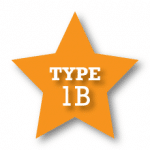CMT forms are usually either demyelinating or axonal in nature, though intermediate forms also exist. Since CMT is a multi-gene disorder, there are many different genes that cause the disorder when mutated. Since 1991, more than 100 different genes causing CMT have been identified and the list continues to grow. CMT can be divided into types and subtypes. The types are the clinical pictures of CMT (CMT type 1, 2, 4, X, etc.), usually defined by inheritance pattern and nerve conductions. Subtypes (CMT1A, 2B, 4C, X1, etc.) are given only when the genetic cause is known. Each subtype corresponds to a gene: Every person with CMT2B, for example, has a mutation in the RAB7 gene and everyone with CMT4C has two mutations in the SH3TC2 gene. (If you would like more information and advanced descriptions about CMT types please go to the Rare Diseases Clinical Research Network (RDCRN) to learn more.)
The most common types/subtypes are listed below. Each has a short description of the genetic cause, and if research is being conducted on that particular type/subtype, there will be a link to the research page.
CMT Type 1
CMT Type 1 (CMT1) is defined as an autosomal dominant (see inheritance.) demyelinating form of CMT. CMT1 accounts for about 55 percent of all cases of CMT.
-
-
Type 1A

CMT1A is the most common form of CMT, comprising around 66 percent of all patients with CMT1. The disorder is caused by a duplication of the PMP22 gene on Chromosome 17. Instead of having two copies of the gene (one from each parent), there are three copies, two on one chromosome and one on the other. PMP22 is a peripheral myelin protein, but its exact function in causing CMT is still not known. CMT1A usually presents with a typical CMT phenotype (clinical presentation). Usually, people with CMT1A are slow runners in childhood, develop high arches and hammertoes and often require orthotics (braces) for ankle support. Varying degrees of hand weakness occur, often appearing as much as 10 years after foot and leg problems. Problems with balance because of ankle weakness and loss of proprioception (the brain’s ability to know where the limbs are in space) are common. Most patients (95 percent) remain ambulatory throughout their lives and life expectancy is normal.
-
-
-
Type 1B

CMT1B is caused by mutations in the MPZ, or peripheral myelin protein, gene. There is a wide range of severity within CMT1B, from very severe, infantile onset to milder cases with onset much later in life. About 40 percent of people with CMT1B have an infantile onset with delayed walking (after 15 months), and development of symptoms before 5 years of age. Hip dysplasia and optic nerve atrophy have been observed in this group (though hip dysplasia may happen in up to 20 percent of kids with CMT), and scoliosis in about a third of people. People with early-onset CMT1B tend to have very slow nerve conduction velocities, with speeds <15 m/s in the arms (normal >50 m/s). A minority (7 percent) of people with this disease-causing variant in the MPZ gene have a childhood onset, with symptoms between 6 and 20 years of age. This group tends to have slow nerve conductions, between 15 and 25 m/s. The remainder of people with CMT1B have an adult onset, with symptoms tending to begin after age 40 and a comparatively milder presentation. Their nerve conduction studies tend to be in the intermediate range of between 35 and 45 m/s.
-
-
-
Type 1C

CMT1C is caused by disease-causing variants in the LITAF gene, also previously referred to as SIMPLE. This is a rare form of CMT, affecting fewer than 1 percent of people who have the disease. Presentation is similar to CMT1A, with onset between the first and third decades, and weakness in the feet and hands, atrophy, and sensory loss and slow nerve conduction velocities (16-25 m/s).
-
-
-
Type 1D

CMT1D is caused by mutations in a gene on chromosome 10 called EGR2, which codes for the early growth response protein 2. CMT1D is very rare and causes less than 1 percent of cases of CMT. Most people with CMT1D show severe symptoms in the first decade of life, including delayed motor milestones and nerve conduction velocities of 10 m/s or less (sometimes referred to as Dejerine Sottas syndrome). A few cases of CMT1D have milder symptoms that appear later in life. Other symptoms may include cranial nerve dysfunction and respiratory difficulties. There have been extremely rare reports of EGR2 causing an autosomal recessive form of CMT, termed CMT4E.
-
-
-
Type 1E

Point mutations in the PMP22 gene cause CMT1E. People with CMT1E tend to have earlier onset and more severe symptoms than those with CMT1A, but this may vary. Conduction velocities in patients tend to be markedly reduced, usually under 10 m/s (normal in the arms is >50 m/s). Children often present within the first two years of life with delayed walking. Many people do progress to needing ambulation aids, such as a walker or a wheelchair, earlier than those with CMT1A. CMT1E is a rare form of CMT, accounting for approximately one percent of people with genetically confirmed CMT.
-
-
-
Type 1F

CMT1F accounts for a very small percentage of cases. It is an autosomal dominant form of CMT in which the defect is on Chromosome 8 and the neurofilament light chain protein.
-
-
-
Type 1X

CMT1X is the second most common form of CMT, accounting for 10 – 16 percent of all cases. The gene that causes CMT1X is GJB1 (previously referred to as Cx32), and the protein is called connexin 32. This gene is found on the X chromosome, one of the sex chromosomes. Females have two X chromosomes (XX) and males have an X and a Y chromosome (XY). Because males only have one copy of the X chromosome, they only have one copy of this gene. If there is a variant in the gene that causes it not to work, males do not have a “backup” copy to help make connexin 32 protein. Females have an extra copy of the gene. Females tend to be less severely affected than the males in their family, but 90 percent have some symptoms. About two-thirds of affected women have symptoms in the mild range and one-third have symptoms in the moderate range. Most males have moderate to severe neuropathy as they age.
The CMT genes found on the X chromosome have a different form of inheritance, called X-linked inheritance. In every pregnancy, the female passes down one copy of a chromosome pair and her partner passes down the other copy for the pair. In order for a child to be born female, she must inherit the X chromosome from her dad. In order for a child to be born male, he must inherit the Y chromosome from his dad. A woman will pass down one or the other of her two X chromosomes in every pregnancy. Each child of a woman affected with CMT1X has a 50/50 risk of inheriting the condition, no matter the sex of the child. A man affected with CMT1X will pass it on to ALL of his daughters (since they inherit his X chromosome with the GJB1 gene variant), but NONE of his sons (who inherit the Y chromosome which does not have a GJB1 gene). The sex of the parent or the child ONLY matters in X-linked inheritance.
-
-
-
Hereditary Neuropathy with Liability to Pressure Palsies (HNPP)
HNPP is inherited in an autosomal dominant pattern. Like CMT1A, HNPP is caused by changes to the PMP22 gene on Chromosome 17. Unlike CMT1A, where the PMP22 gene is duplicated, one of two PMP22 gene copies is deleted. Instead of having two copies of PMP22 (one from each parent), HNPP patients only have one copy. This means that patients with HNPP do not produce enough of the PMP22 proteins.
Patients with HNPP typically present in the second or third decade with recurrent, focal symptoms such as numbness, tingling, muscular weakness and pain. These episodes are often brought on by mild physical activities innocuous to healthy person. The activities include nerve compression like sitting with legs crossed or leaning on elbows, repetitively doing the same movements and over-stretching limbs. It can take anywhere from hours to months to recover from an episode.
While most episodes are transient, some patients with HNPP may experience permanent weakness. Many patients with HNPP may also develop intolerable fatigue. There is a wide range in the severity of symptoms. Some patients may be asymptomatic while others experience symptoms similar to typical CMT. HNPP may cause severe limb paralysis when asymptomatic patients with unknown diagnosis of HNPP are challenged by strenuous physical activities such as running 10 miles a day with 50lb backpack. This could impose a catastrophic risk in a fraction of asymptomatic patients with undiagnosed HNPP. Life expectancy for people with HNPP is normal.
-
CMT Type 2
CMT Type 2 represents axonal forms that are dominantly inherited and make up about one-third of all dominant CMT cases. The clinical presentation is similar to Type 1: distal weakness, muscle atrophy, sensory loss and foot deformities. Patients with Type 2 have a wider age range for onset of the disorder and more variation in degree of disability. They are slightly more likely to maintain their deep tendon reflexes.
-
-
Type 2A

The defect causing CMT2A is found on chromosome 1p36 at the MFN2 gene. This gene is mutated and is involved in the fusion of mitochondria, the metabolic engines of the cells.
-
-
-
Type 2A2B

CMT2A2B is the recessive form of CMT2A. Historically, KIF1B was originally published as causing CMT2A. That turned out to be incorrect, but the paper was never retracted, so when the real cause—MFN2— was identified, they differentiated by labeling KIF1B mutations as CMT2A1 and MFN2 mutations as causing CMT2A2. CMT experts do not agree with this designation, and most just call it CMT2A for all MFN2 mutations as the other gene is not something we see. However, some mutations in MFN2 only become a problem when you have mutations in both copies of the gene, and therefore to distinguish this they added the classification CMT2A2A for the dominant form of MFN2 mutations and CMT2A2B for the recessive form of MFN2 mutations.
Dominant forms of MFN2 mutation cause a gain of toxic function, so essentially the abnormal protein is blocking the function of the working protein and somehow treatment will need to silence that abnormal copy or cut it out. If it can be silenced, blocked or cut it out so it is not being made, then the working copy of MFN2 may be able to help with the function of that protein.
However, for the recessive forms of MFN2, patients probably have a loss of function because there are mutations in both copies of the gene. In that case, function may potentially be restored by somehow replacing the mutated genes with a healthy working copy of MFN2 or by enhancing (turning up the volume) of MFN1, which is a similar gene and has a similar protein function in the body.
-
-
-
Type 2B

CMT2B is characterized by severe ulceration problems and the defect is located on chromosome 3, the RAB 7 protein. CMT 2B is predominantly a sensory disorder and there is some thought that it is not really CMT, but a pure sensory neuropathy.
-
-
-
Type 2C

CMT2C is a very rare form in which patients may have diaphragm or vocal cord paresis in addition to the other problems of CMT. Linkage to chromosome 12 has been found.
-
-
-
Type 2D

The CMT2D locus is on chromosome 7p14 and the genetic cause has been identified as mutations in the glycyl RNA synthetase gene. CMT2D is a confusing disorder because some patients have sensorimotor neuropathies, while others have only motor symptoms.
-
-
-
Type 2E
 CMT2E has been established with linkage to chromosome 8p21 and studies have identified mutations in the neurofilament light gene.
Research on CMT Type 2E
CMT2E has been established with linkage to chromosome 8p21 and studies have identified mutations in the neurofilament light gene.
Research on CMT Type 2E
-
-
-
Type 2F

Dominant mutations in HSPB1 have been reported to cause CMT2F. Other mutations also known to cause CMT2F produce a more purely motor phenotype, HMN IIb. The clinical onset of weakness ranges from the second to the fourth decade, followed by the development of prominent weakness in the distal muscles of the legs then arms.
-
-
-
Type 2K

CMT2K is caused by dominantly inherited mutations in the GDAP1 gene (as opposed to CMT4A, which is inherited in a recessive manner). About 25% of people with mutations in GDAP1 have CMT2K, and 75% have the recessive CMT4A (two mutations in the gene). Symptom onset varies, with about ¼ of people having symptoms before age 10 years, 41% between 10 and 30 years, 20% over 30 years, and 14% asymptomatic after 50 years of age. Less than 10% of people with CMT2K need a wheelchair full-time.
-
-
-
Type 2O

CMT2O is caused by disease-causing variants in the DYNC1H1 gene. This is usually a pure motor form of CMT, with little to no sensory symptoms, with axonal nerve conduction studies. So far, only one variant in this gene has been found to cause CMT2O (c.917A>G, p.His306Arg). Other variants in this gene have been associated with a variety of conditions, some similar to CMT (spinal muscular atrophy with lower extremity predominance (SMA-LED) – lower limb weakness and pes cavus, scoliosis, hip weakness), and some less similar (complicated hereditary spastic paraplegia (cHSP), and malformations of cortical development (MCD) – both which include intellectual impairment).
-
-
-
Type 2P

CMT2P is a rare form of CMT, caused by mutations in the LRSAM1 gene. There have only been a handful of reports of this type in the literature, so more research is needed to understand the range of presentation for people with this type of CMT. The clinical phenotype can be summarized as a relatively mild, very slowly progressive axonal neuropathy with age of onset in the second or third decade of life. Most people after age 30 years have some motor symptoms and pes cavus. There are a couple of reports of fasciculations, or involuntary muscle twitches, in the legs. There are several reports of erectile dysfunction. People may have an elevated serum creatine kinase (CK) level, a measure of leaky muscles (not commonly elevated in CMT).
-
-
-
Type 2S

CMT2S was first discovered by Dr. Ellen Cottenie in 2014 (http://www.cell.com/ajhg/fulltext/S0002-9297(14)00424-8). After publication of her article, it was officially registered in the genetic database. CMT2S is caused by a mutation in the IGHMBP2 gene. IGHMBP2 gene mutations can present with two different phenotypes: 1) the severe SMARD1 (Spinal Muscular Atrophy associated with Respiratory Distress) or 2) the milder CMT2S. Both are rare and recessive in nature. Depending on the specific mutations, patients either have SMARD1, caused by autosomal recessive mutations in the IGHMBP2 gene (which is not related to the myelin protein MBP), or they have CMT2S, which results in slowly progressive weakness, wasting, and sensory loss with an axonal neuropathy typical of CMT2, but without significant respiratory compromise.
-
-
-
Type 2Z

CMT2Z stems from disease-causing variants in MORC2. Some people present with generalized weakness in infancy while others present with adult-onset weakness that may include proximal muscles and sensory loss. Many people’s first symptom is cramping in the legs. This form of CMT is length-dependent (meaning that it affects the nerves farthest from the spine first and then travels up), as is typical for CMT, but over decades it progresses to muscles above the knees and elbows, including the hip muscles, deltoids and neck muscles. People with CMT2Z may require progressive ambulation aids over time, with most needing a wheelchair around the fifth decade. This may end up being a very common form of axonal CMT, but because it was only associated with CMT in 2016, it will take some time to see what proportion of the population has CMT2Z. This gene also seems to have a high new mutation rate, with one paper estimating that up to 75 percent of people are the first in their families with disease-causing variants in MORC2.
-
CMT Type 4
All Type 4 instances of CMT are inherited in an autosomal recessive pattern (see inheritance) and are rare in the United States (~5% of cases). They have various presentations, with some being mild and some severe. These disorders may also have symptoms in other areas of the body, such as cataracts and deafness.
-
-
Type 4A

CMT4A is caused by mutations in the GDAP1 gene. This gene has been found to cause CMT4A (recessive, demyelinating, axonal or intermediate CMT – about 75% of people with GDAP1 mutations), and CMT2K (dominant axonal CMT – about 25% of people with GDAP1 mutations). People with CMT4A have onset of symptoms in the first two decades of life, most before age 10 years. Symptoms affect both lower and upper limbs, including muscle wasting and contractures, and delayed milestones such as sitting and walking. Most people need walking assistance, such as AFOs, canes or walkers, by 30 years of age, and about 75% use a wheelchair after 30 years. As disease progresses, a hoarse voice can develop and vocal cord paresis have been reported. Life expectancy and intelligence are not affected.
-
-
-
Type 4B

The genetic location for the defect causing CMT4B is on chromosome 11 and presents with focally folded myelin sheaths in nerve biopsies. Affected patients become symptomatic early in life, with an average age of onset at 34 months. Unlike most types of CMT, both proximal and distal weakness is common.
-
-
-
Type 4C

CMT4C is caused by mutations in SH3TC2 and has a wide variability of severity. This type of CMT involves childhood onset of sensory and motor neuropathy in the lower limbs and high arched or flat feet. Patients often have mild difficulty with walking, and some may need a wheelchair. Scoliosis is almost always present, usually onset in the first two decades. The onset of neuropathy symptoms range, some beginning in the first decade of life, and others do not onset until adulthood. Lower limb and upper limb weakness is common, beginning towards the hands and feet and sometimes extending above the elbows and knees. Hearing loss, vocal cord involvement, and facial paresis have been reported. This is a demyelinating form of CMT, with conductions usually ranging between 16 and 36 m/s in the arms.
-
-
-
Type 4D

CMT4D was first described as a separate disorder with linkage to Chromosome 8 in a Gypsy population with autosomal recessive inheritance. The clinical features included distal weakness, muscle wasting and sensory loss, foot and hand deformities and loss of deep tendon reflexes. Deafness is always found in these patients and occurs by the third decade. Nerve conduction is severely reduced in younger patients and completely unattainable after age 15.
-
-
-
Type 4F

CMT4F is a severe form of recessive CMT that has been defined in a large Lebanese family with mutations in the PRX gene on Chromosome 19. Nerve conduction studies are markedly slow and onion bulb formations are observed in nerve biopsies.
-
-
-
Type 4J

CMT4J is caused by mutations in a gene called FIG4, which is located on chromosome 6. This is a rare form of CMT that wasn’t identified until 2007. Because not many people have this form, our understanding of how it progresses is limited. Symptoms and age of onset are variable; some people have a classic presentation, while others have a slowly progressive neuropathy with more severe changes later in adulthood. CMT4J causes intermediate to slow nerve conductions due to changes in the myelin, the sheath around the nerve “wire.” It is an autosomal recessive form of CMT (CMT4), which means an individual has to have a mutation in each copy of the gene (one from each parent) in order to have symptoms. Not all changes in FIG4 cause disease, however. If one of an individual’s two mutations is benign, he or she would not have CMT4J.
-
Read about the Patients as Partners in Research Initiative ⟶


















 CMT2E has been established with linkage to chromosome 8p21 and studies have identified mutations in the neurofilament light gene.
CMT2E has been established with linkage to chromosome 8p21 and studies have identified mutations in the neurofilament light gene.











